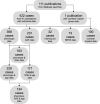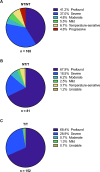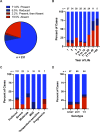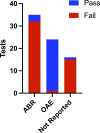The natural history, clinical outcomes, and genotype-phenotype relationship of otoferlin-related hearing loss: a systematic, quantitative literature review
- PMID: 37679651
- PMCID: PMC10511631
- DOI: 10.1007/s00439-023-02595-5
The natural history, clinical outcomes, and genotype-phenotype relationship of otoferlin-related hearing loss: a systematic, quantitative literature review
Abstract
Congenital hearing loss affects one in 500 newborns. Sequence variations in OTOF, which encodes the calcium-binding protein otoferlin, are responsible for 1-8% of congenital, nonsyndromic hearing loss and are the leading cause of auditory neuropathy spectrum disorders. The natural history of otoferlin-related hearing loss, the relationship between OTOF genotype and hearing loss phenotype, and the outcomes of clinical practices in patients with this genetic disorder are incompletely understood because most analyses have reported on small numbers of cases with homogeneous OTOF genotypes. Here, we present the first systematic, quantitative literature review of otoferlin-related hearing loss, which analyzes patient-specific data from 422 individuals across 61 publications. While most patients display a typical phenotype of severe-to-profound hearing loss with prelingual onset, 10-15% of patients display atypical phenotypes, including mild-to-moderate, progressive, and temperature-sensitive hearing loss. Patients' phenotypic presentations appear to depend on their specific genotypes. For example, non-truncating variants located in and immediately downstream of the C2E calcium-binding domain are more likely to produce atypical phenotypes. Additionally, the prevalence of certain sequence variants and their associated phenotypes varies between populations due to evolutionary founder effects. Our analyses also suggest otoacoustic emissions are less common in older patients and those with two truncating OTOF variants. Critically, our review has implications for the application and limitations of clinical practices, including newborn hearing screenings, hearing aid trials, cochlear implants, and upcoming gene therapy clinical trials. We conclude by discussing the limitations of available research and recommendations for future studies on this genetic cause of hearing loss.
© 2023. The Author(s).
Conflict of interest statement
CLF is a consultant for Decibel Therapeutics. WJR, TQ, OPK, JPW, and VV are employees of, and hold equity in, Decibel Therapeutics.
Figures








References
-
- Akil O, Dyka F, Calvet C, Emptoz A, Lahlou G, Nouaille S, Boutet de Monvel J, Hardelin JP, Hauswirth WW, Avan P, Petit C, Safieddine S, Lustig LR. Dual AAV-mediated gene therapy restores hearing in a DFNB9 mouse model. Proc Natl Acad Sci USA. 2019;116:4496–4501. doi: 10.1073/pnas.1817537116. - DOI - PMC - PubMed
-
- Alkowari MK, Vozzi D, Bhagat S, Krishnamoorthy N, Morgan A, Hayder Y, Logendra B, Najjar N, Gandin I, Gasparini P, Badii R, Girotto G, Abdulhadi K. Targeted sequencing identifies novel variants involved in autosomal recessive hereditary hearing loss in Qatari families. Mutat Res. 2017;800–802:29–36. doi: 10.1016/j.mrfmmm.2017.05.001. - DOI - PubMed
Publication types
MeSH terms
Grants and funding
LinkOut - more resources
Full Text Sources
Medical

